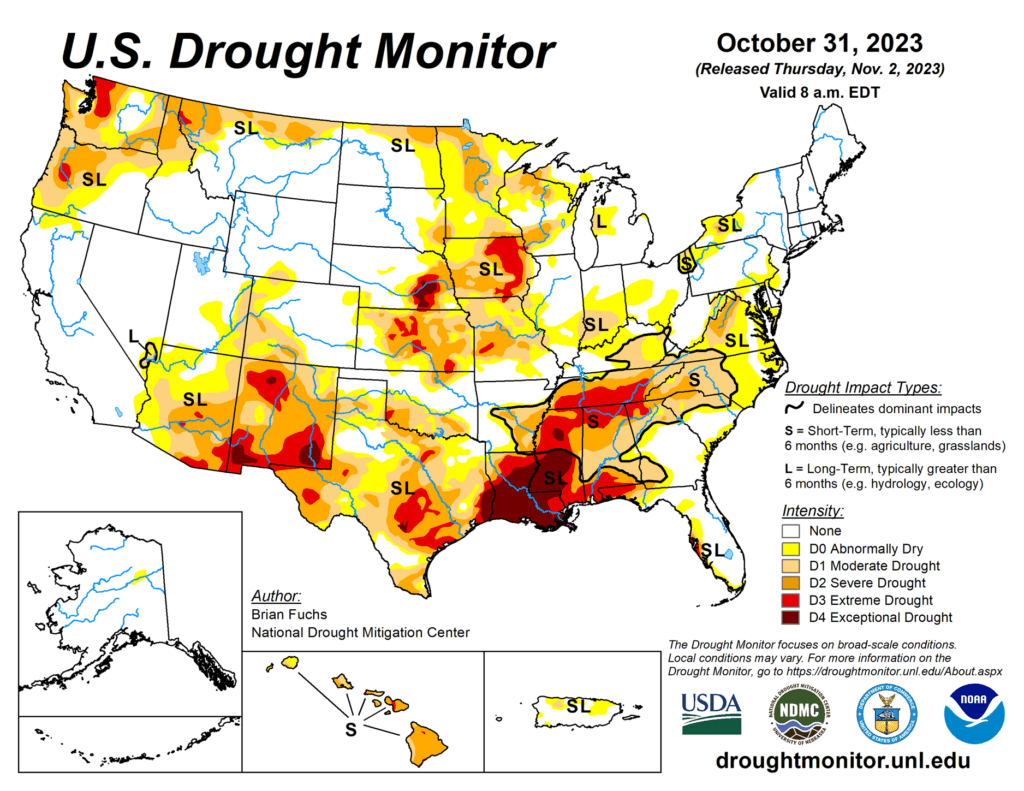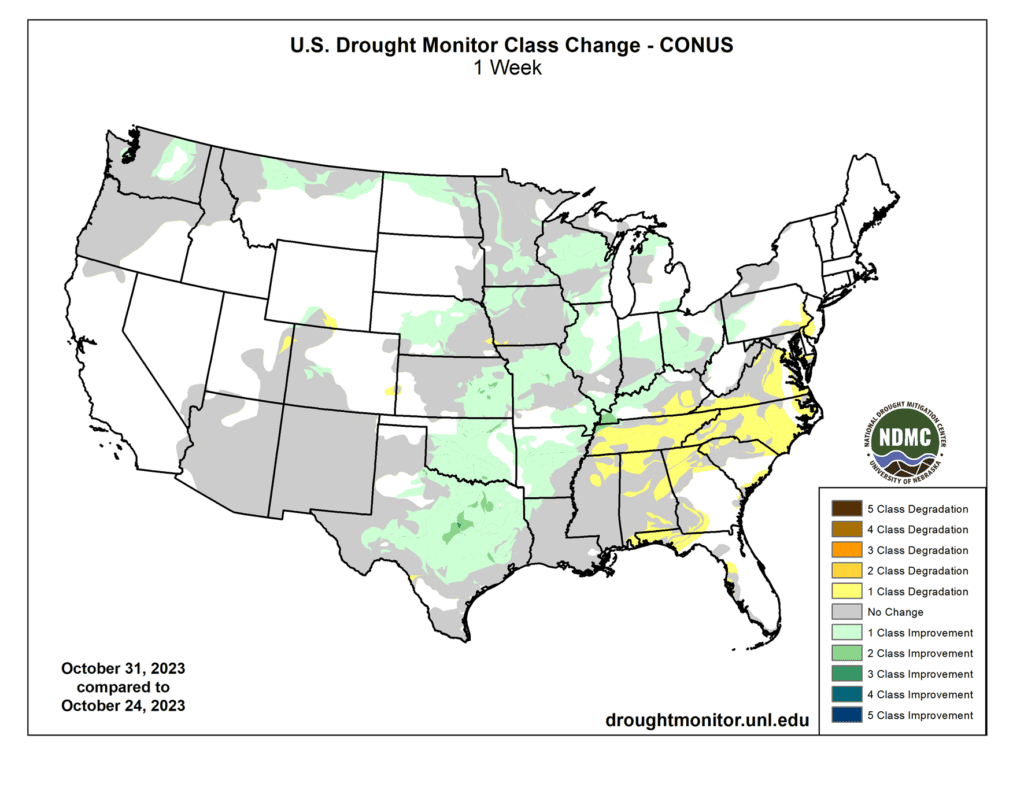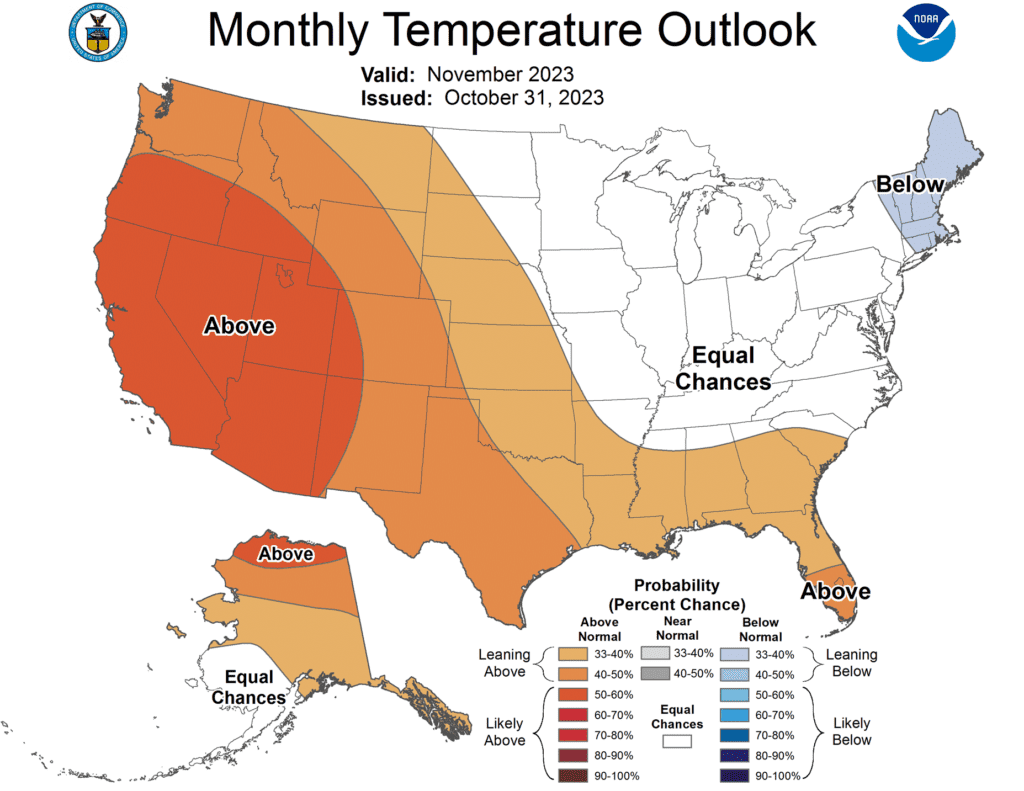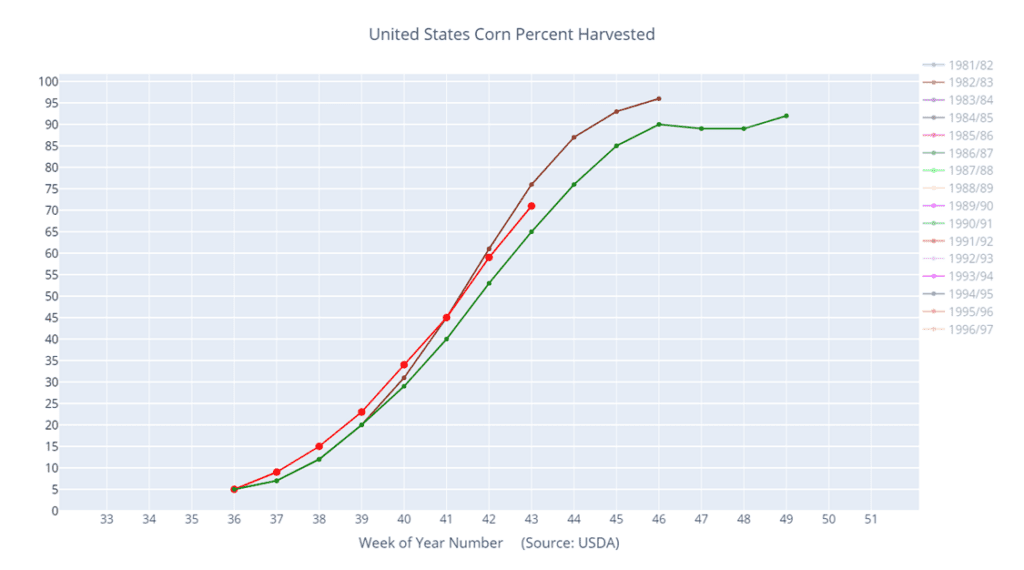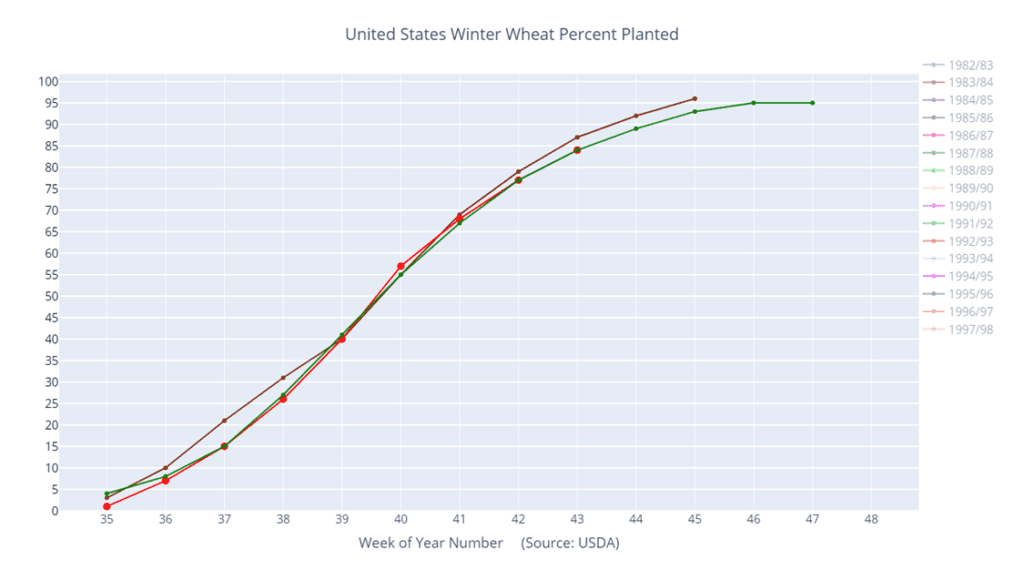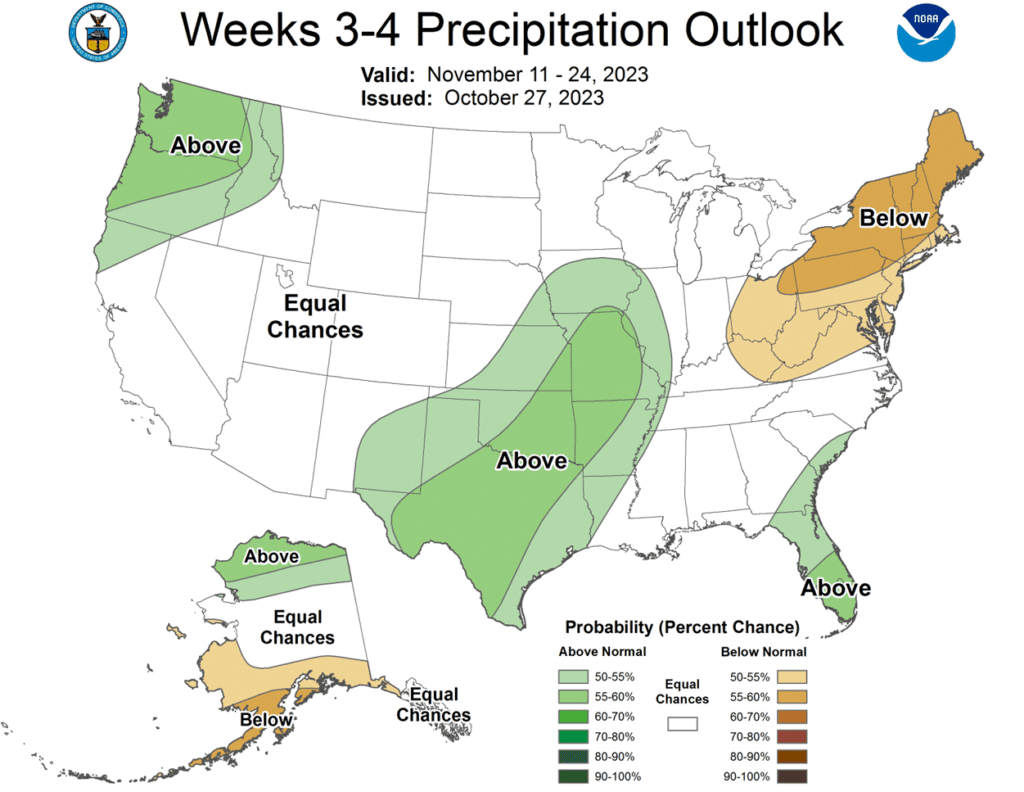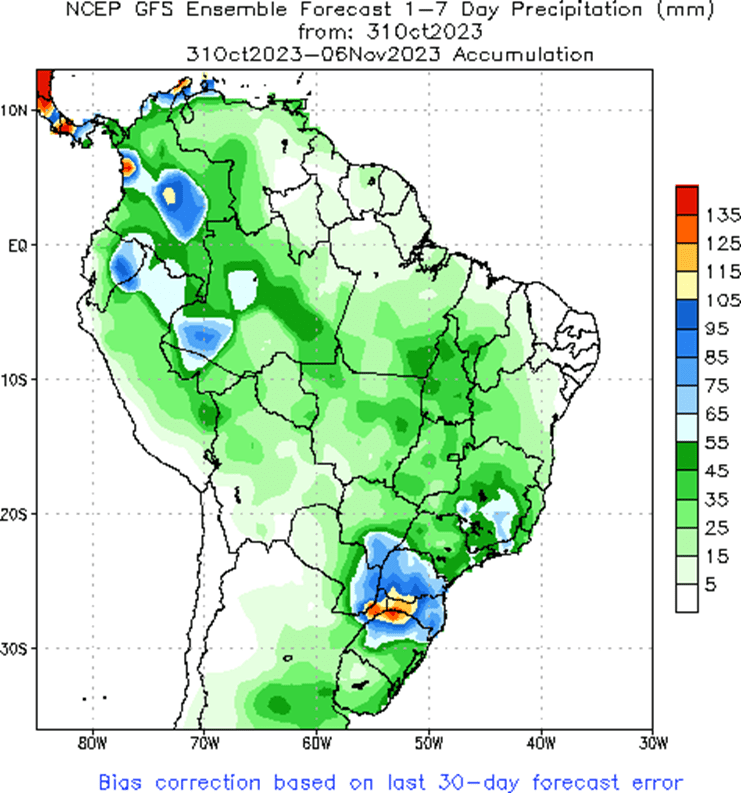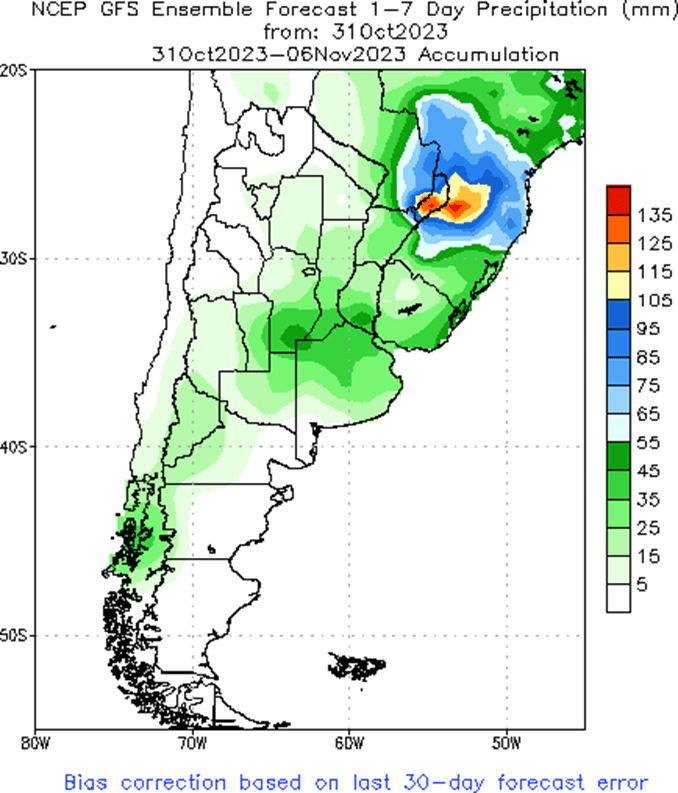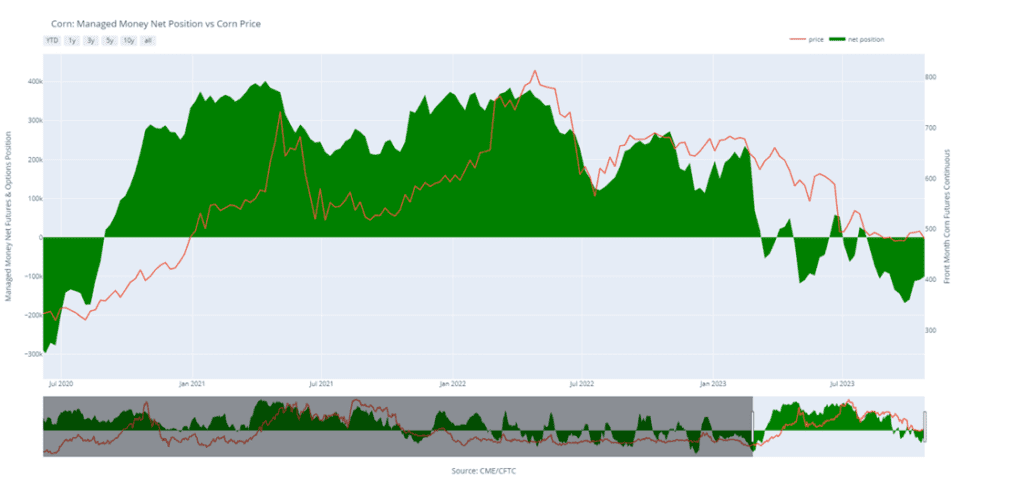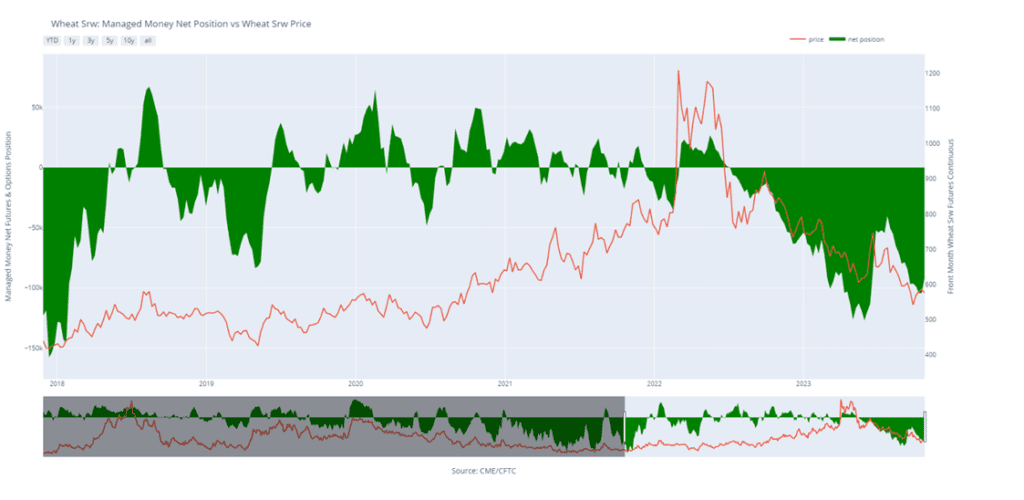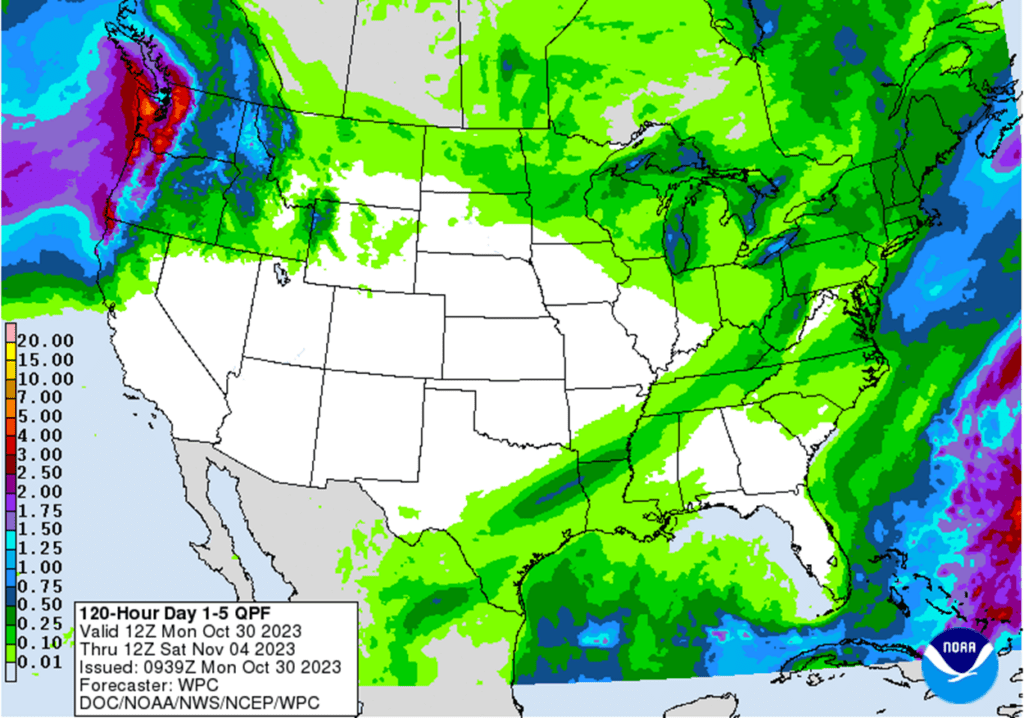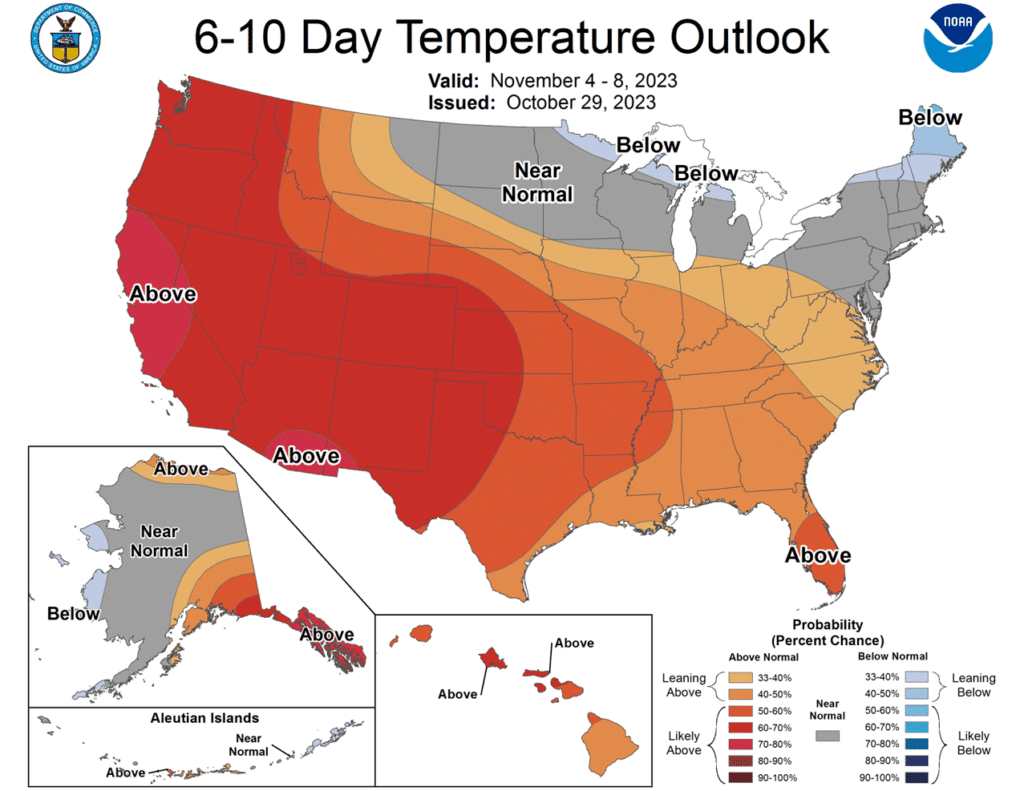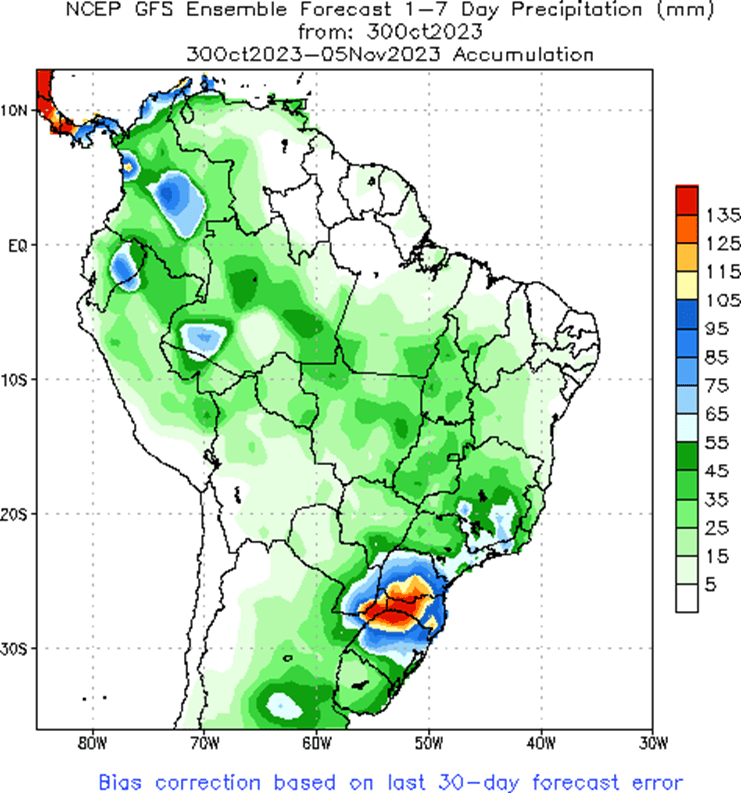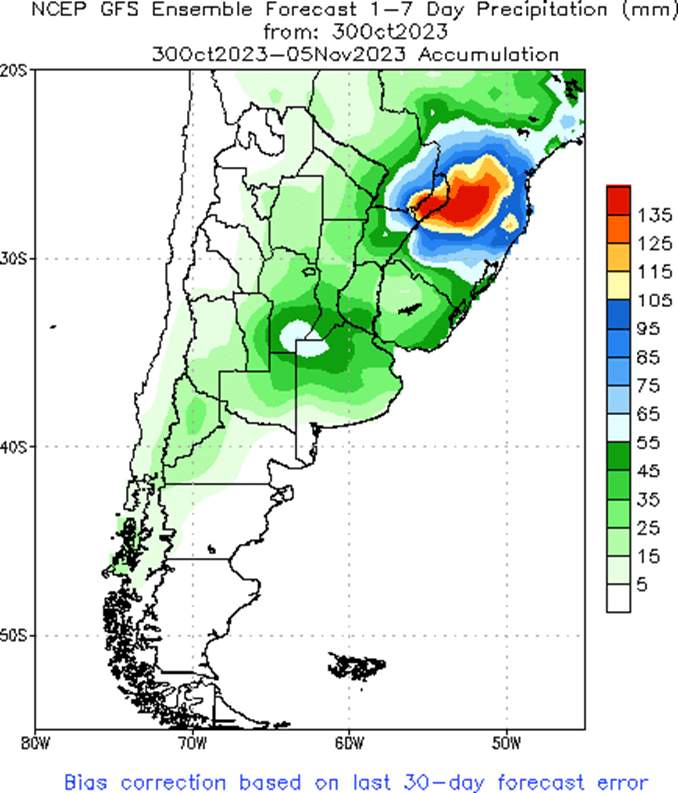11-02-23 End of Day: Technical Selling Presses Corn Lower Despite Higher Beans and Wheat
All prices as of 2:00 pm Central Time
Grain Market Highlights
- Despite decent ethanol production, lackluster export demand, harvest pressure, and continued technical selling dominated the corn market, pressing it to its lowest level since late September.
- Firm export sales, record September crush numbers, and analysts’ expectations of lower yields ahead gave the soybean market a strong push to end higher on the day, despite a mixed close for the products and a loss of 17 cents in December Board crush margins.
- Disappointing soybean meal exports likely led to profit taking and a lower close in front month meal after trading higher overnight, while reports of the lowest soybean oil stocks since 2017 and strong crude oil supported bean oil to a positive close after printing a new 4-month low.
- A weak US dollar, renewed supply concerns from Ukraine, and a reduction in Russian wheat exports, all added levels of support to the wheat complex that opened weak but settled on the positive side of unchanged in all three classes.
- Falling treasury yields in the overnight, carried over to the day session and weighed heavily on the US dollar, which gapped lower as trading opened, giving up all of yesterday’s gains. The lower dollar likely provided support to US commodity markets.
- To see the November US Drought Monitor and weekly change maps, courtesy of the NDMC and the University of Nebraska, and the South American 1-week forecast precipitation maps for South America, courtesy of the NWS, and CPC, scroll down to other Charts/Weather Section.
Note – For the best viewing experience, some Grain Market Insider content is best viewed with your phone held horizontally.
Corn
Corn Action Plan Summary
- No new action is recommended for 2023 corn. On October 19, December corn closed above 500 for the first time since the end of July. While the market was unable to follow through to the upside, the overall trend remains positive with successively higher lows, from mid-August. If the market can maintain a close above 500 and the 100-day moving average, it may aim to test resistance near 547. Otherwise, if the market closes below the 50-day moving average near 485, it may run the risk of continuing to trend sideways to lower, with a worst-case scenario being a sideways to lower trend into late November, or even early January. During last summer’s June rally, Grain Market Insider recommended making sales when Dec ’23 was around 624. So, for now, the thought process is to hold tight on any further sales recommendations until later this fall or early winter, with the objective of seeking out better pricing opportunities. If the market has not turned around by early winter, then Grain Market Insider may sit tight on the next sales recommendations until spring. If you end up harvesting more bushels than you can store this fall and must move them, consider protecting those sold bushels with either July or September ’24 call options.
- No new action is recommended for 2024 corn. The Dec ’24 contract has held up better than Dec ’23 as bear spreading over the last several months has brought increased buying interest into Dec ’24 and other further out contract months. Back in late July, the Dec ’23 contract traded up to a 25-cent premium over Dec ’24. Now, Dec ’24 holds about a 30 cent premium over Dec ’23. This bear spreading has held the Dec ’24 price up about 28 cents from its year-to-date low. The risk for 2024 prices is the same as for 2023 prices, which is a continuation of a lower trend without further bullish input. Grain Market Insider is watching for signs of a change in the current trend to look at recommending buying Dec ’24 call options. This past spring, Grain Market Insider recommended buying 560 and 610 Dec ’23 call options ahead of the summer rally and having those in place helped provide confidence to pull the trigger on recommending 2023 sales into that sharp rally, knowing that if corn kept rallying and went to 700 or 800 that the call options would protect those sold bushels.
- No Action is currently recommended for 2025 corn. Grain Market Insider isn’t considering any recommendations at this time for the 2025 crop that will be planted two springs from now. It will probably be late winter or early spring of 2024 before Grain Market Insider starts considering the first sales targets.
To date, Grain Market Insider has issued the following corn recommendations:
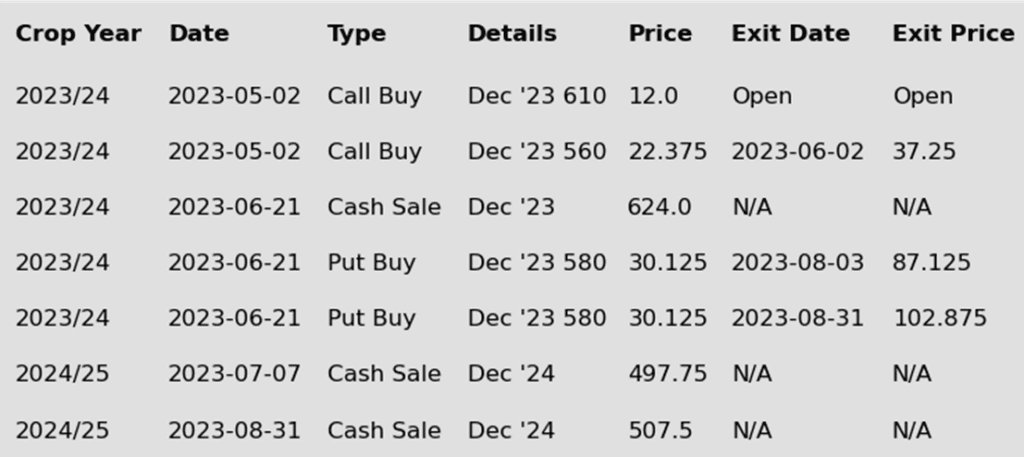
- Weak price action triggered by hedge pressure and technical selling weighed on corn futures during the session, despite overall commodity market strength on Thursday. December corn lost 5 cents and posted its lowest close since September 27, 2021.
- Weekly export sales for corn were within expectations but lackluster. The USDA reported new sales of 748,000 mt (29,5 mb) for the current marketing year. Mexico was the top buyer of US corn last week. Year-over-year, corn export sales are up 26%, but still behind the pace needed to reach USDA’s marketing year export targets.
- Ethanol margins should remain friendly and supportive of the corn market in the near term. Ethanol production has remained strong, but ethanol stocks are historically low. The combination should keep the ethanol processor active in the corn market, and in need of supply.
- The weak price action and negative close will likely keep short sellers active in the corn market. The downside trend under the December contract points to a test of the fall low and possibly the 460 level if selling pressure continues.
- South American weather is forecasted to stay hot and dry for areas of Brazil, and parts of Argentina are seeing signs of last year’s drought persist. While South American weather is still in its early stages, weather will grow of more importance in the weeks ahead. If soybean planting stays delayed, that could push planting of the key 2nd corn crop past the ideal weather window.

Above: The market has been drifting lower since trading up to 509 ½ and failing on October 20, and upside resistance has moved lower with it. Currently, nearby resistance rests between 476 and 486, with major support remaining near 460. Below 460, the next level of support may come in between 440 and 414.

Soybeans
Soybeans Action Plan Summary
- No new action is recommended for 2023 soybeans. At the end of August, the soybean market turned lower and didn’t find any significant buying interest until it traded down to 1251 in early October. Since then, the nearby contract rallied through resistance near 1287 on its way to the recent high of 1334 and testing the 50-day moving average. Looking back, since last May, nearby soybeans have been in a range from 1435 up top to 1251 down below. Last summer, Grain Market Insider did make two sales recommendations in the 1310 – 1360 price window versus Nov ’23. Given that those sales recommendations were made and given that now is not the time of year to be making many sales, if any, Grain Market Insider is content to hold tight on any further sales recommendations until later this fall or early winter. The focus for strategy right now is to be on the lookout for any call option buying opportunities. If you end up harvesting more bushels than you can store this fall, consider protecting any sold bushels with July or Aug ’24 call options.
- No action is recommended for the 2024 crop. Nov ’24 has traded at a discount to the 2023 crop for nearly its entire contract life and that discount extended out to 142 versus the Jan ’24 contract in late July, with it recently trading between 17 ¾ and 66 cents. Since July, the Nov ’24 contract has mostly traded between 1250 and 1320 and is currently testing the bottom end of that range. To date, Grain Market Insider has not recommended any sales for next year’s soybean crop. First sales targets will probably be early winter at the soonest. Currently, Grain Market Insider’s focus is also on watching for any opportunities to recommend buying call options.
- No Action is currently recommended for 2025 Soybeans. Grain Market Insider isn’t considering any recommendations at this time for the 2025 crop that will be planted two springs from now, and it may be some time before conditions are conducive to consider making any recommendations. Be patient as we monitor the markets for signs of improvement.
To date, Grain Market Insider has issued the following soybean recommendations:

- Soybeans ended the day firmly higher following good export sales and some analyst expectations that the national soybean yield may decrease. Crude oil gained over two dollars a barrel today which, along with gains in palm oil, supported soybean oil. Soybean meal was bear spread with the front months lower but deferred contracts higher.
- Soybean export sales have begun picking up with China as a more active buyer, and today’s export sales report showed increases of 37.1 mb for the 23/24 marketing year which was on the higher end of analyst expectations. Shipments were huge at 73.2 mb and much higher than the 32.6 mb needed on average to meet the USDA’s expectations.
- Today’s Fats and Oils report showed September soybean crush at 175 mb, in line with analysts’ expectations and the largest September crush on record. Soybean oil stocks were down 25% from a year ago, but soybean meal stocks were reportedly 18% higher than a year ago despite the export demand.
- In South America, excessive rain in the southern region and dryness in the northern regions of Brazil have some analysts expecting that the final soybean crop will be closer to 150 mmt rather than the 163 mmt that the USDA has estimated. Lower South American production coupled with tight US ending stocks could give soybeans momentum to rally.

Above: In the middle of October, the market traded up to 1334 and pierced the upper end of resistance, and the 50-day moving average, before retreating lower. If the market can maintain a close above resistance at 1334, it would be poised to make a run to test 1370. Otherwise, initial support to the downside may be found near 1300 and again near 1273. Key support for the move remains down near 1250.

Wheat
Market Notes: Wheat
- Wheat managed to make small gains in all three US classes. The US Dollar Index gapped lower after yesterday’s Fed comments indicated that interest rates would be kept unchanged. This may have eased some pressure on the wheat market, allowing for small, but welcomed gains in price. If the US dollar continues to trend lower, the export market may begin to pick up, providing more long-term support.
- The USDA reported export sales of 10.1 mb of wheat, bringing the 23/24 total to 417.5 mb, down 7% from last year. About 14.2 mb of wheat need to be shipped each week to meet the USDA’s export goal of 700 mb, but shipments last week of just 3.7 mb were well below that figure.
- Rumors continue to circulate that China is looking for US SRW wheat pricing out of the Gulf, and so far there has been no confirmation of any purchases. However, they have recently purchased a combined total of 4.5 mmt from France and Australia.
- There is renewed concern about grain flow out of Ukraine. Apparently, Russia has planted explosives along Black Sea shipping lanes. In addition, Ukraine has new export registration and license requirements that may slow down exports of wheat and corn.
- SovEcon reduced their estimate of Russian wheat exports to 48.8 mmt from 49.2 mmt previously. Reportedly, wheat export sales have significantly declined recently, and it may be tied, in part, to the government’s attempt to limit exports at these recent low levels. In addition, the Russian agriculture ministry is proposing a six-month ban on durum wheat exports from December 1 – May 31.
Chicago Wheat Action Plan Summary
- No new action is currently recommended for 2023 Chicago wheat. Since making a mid-summer high in late July, the Dec ’23 contract has been in a downtrend, but after finding support at 540 on September 29, the market has steadily rallied, briefly piercing 600 and the 50-day moving average. With weak US export demand driven by cheap Russian exports being the dominant headwind, it appears that prices may be finding value in the 540 – 616 range established since early September. Grain Market Insider made sales recommendations in the late June rally around 720, and again earlier this fall near 604. With those two sales, Grain Market Insider’s strategy is to look for price appreciation going into this winter as weather becomes a more prominent market mover, with an eye on considering additional sales in the 625 – 650 range. If at that point the market remains strong and continues to rally, Grain Market Insider will consider potential re-ownership strategies to protect current sales and add confidence to make additional sales at higher prices.
- No new action is recommended for 2024 Chicago wheat. The July ’24 contract has been trading at a premium to the Dec ’23 contract since late April, which has steadily increased to about 55 cents, September 29, it traded as far out as 71 ¾ cents. Fund positioning and weak fundamentals have driven Dec ’23 closer to the mid to upper 500 range, and July ’24 to the low to mid 600’s. The market risk for July ’24 remains the same as for Dec ’23. The market needs bullish input to move prices higher, and without it, prices may continue to erode. At the end of August, Grain Market Insider recommended purchasing July 590 puts to prepare for this possibility, and back in June, Grain Market Insider recommended two separate sales that averaged about 720 to take advantage of the brief upswing. If the market receives the needed stimulus to move prices back toward June’s highs, Grain Market Insider is prepared to recommend adding to current sales levels. Otherwise, the current recommended put position will add a layer of protection if prices erode further, and Grain Market Insider will be prepared to recommend covering some of those puts to offset some of the original cost and move toward a net neutral cost for the remaining position.
- No action is currently recommended for 2025 Chicago Wheat. Grain Market Insider isn’t considering any recommendations at this time for the 2025 crop that will be planted a year from now. It will probably be mid-winter before Grain Market Insider starts considering the first sales targets.
To date, Grain Market Insider has issued the following Chicago wheat recommendations:


Above: On October 20, the December contract posted a bearish reversal after making a new recent high of 604 ½. The market has retreated and solidified resistance above the market that now stands between 604 ½ and 618. Without bullish input, the market is likely to trend sideways to lower with the next major support level between 547 and 540.
KC Wheat Action Plan Summary
- No new action is recommended for 2023 KC wheat crop. With prices falling below the October 12 low of 655 ¼, the Dec ’23 contract continues to search for support as it resumes the downtrend that has been in place since late July. Currently, weak US export demand, driven by cheap Russian exports, remains the dominant headwind, and the market is in need of bullish input to stabilize and rally prices back higher. If a bullish catalyst enters the market to push prices above 700, it may signal that a fall low is in place and would line up with the historical tendency for prices to appreciate into winter and early spring. Grain Market Insider’s strategy is to look for price appreciation going into this winter, as weather becomes a more prominent market mover with an eye on considering additional sales near 750 – 800. If at that point the market remains strong and continues to rally, Grain Market Insider will consider potential re-ownership strategies to protect current sales and add confidence to make additional sales at higher prices.
- No new action is recommended for 2024 KC wheat. The July ’24 contract is currently trading near a 25-cent premium to July ’23, which is up significantly from last July’s 60-cent discount. Weak fundamentals have driven spread activity to push July ’23 toward its contract lows, while July ’24 has been able to maintain more of its value. The risk for the July ’24 contract is much like that for Dec ’23. The market needs bullish input to move prices higher, and without it, prices may continue to erode. In mid-August, Grain Market Insider recommended purchasing July 660 puts to prepare for this possibility, and back in July, Grain Market Insider recommended a sale near 800 to take advantage of elevated prices before they eroded further. If the market receives the needed impetus to move prices back toward 750 – 800, Grain Market Insider is prepared to recommend adding to current sales levels. Otherwise, the current recommended put position will add a layer of protection if prices erode further, and Grain Market Insider will be prepared to recommend covering some of those puts to offset some of the original cost and move toward a net neutral cost for the remaining position.
- No action is currently recommended for 2025 KC Wheat. Grain Market Insider isn’t considering any recommendations at this time for the 2025 crop that will be planted a year from now. It will probably be mid-winter before Insider starts considering the first sales targets.
To date, Grain Market Insider has issued the following KC recommendations:


Above: Since breaking through the bottom of the consolidation range at 655, the market has drifted lower and has now tested minor support near 630, which has held so far. The next level of major support below that remains near 575. Major resistance above the market remains around 690 – 700, with minor resistance near 655.
Mpls Wheat Action Plan Summary
- No new action is currently recommended for the 2023 New Crop. After making highs in July, and the subsequent downtrend to the October 2 low of 707 ½, the Dec ‘23 contract has traded mostly sideways with no significant reversal higher. With weak US export demand still the primary impediment to higher prices, the market remains at risk of trending lower if 707 ½ is violated to the downside unless another bullish impetus enters the scene. If that happens and prices begin to push back toward 775, it may signal that a near-term low is in place. Earlier this year, Grain Market Insider made a sales recommendation during the July rally near 820, and with that sale in place, Grain Market Insider’s strategy is to look for price appreciation going into this winter with an eye on considering additional sales around 750 – 800, and again north of 825. If at that point the market remains strong and continues to rally, Grain Market Insider will consider potential re-ownership strategies to protect current sales and add confidence to make additional sales at higher prices. Even though the primary strategy is to look for higher prices, Grain Market Insider may also consider a “plan b” in the next couple of weeks if prices grind sideways to lower.
- No new action is currently recommended for 2024 Minneapolis wheat. In the last three months, the Sep ’24 contract has gone from a 60 – 80 discount to Dec ’23, to a 50-cent premium. Weak fundamentals led bear spreading to drive Dec ’23 in search of new contract lows, while Sep ’24 remains off its low from last May. The risk for the Sep ’24 contract is much like that of Dec ’23. The market needs bullish input to move prices higher, and without it, prices may continue to erode. In mid-August, Grain Market Insider recommended purchasing July KC 660 puts (for their greater liquidity, and correlation to Minneapolis pricing) to prepare for this possibility, and back in July, Grain Market Insider recommended a sale near 815 to take advantage of elevated prices. If the market receives the needed stimulus to move prices back toward 800, Grain Market Insider is prepared to recommend adding to current sales levels. Otherwise, the current recommended put position will add a layer of protection if prices erode further. Grain Market Insider will then be prepared to recommend covering some of those puts to offset some of the original cost and move toward a net neutral cost for the remaining position.
- No action is currently recommended for the 2025 Minneapolis wheat crop. Grain Market Insider isn’t considering any recommendations at this time for the 2025 crop that will be planted two springs from now. It will probably be mid-winter before Grain Market Insider starts considering the first sales targets.
To date, Grain Market Insider has issued the following Minneapolis wheat recommendations:


Above: Since the last week of October, the December contract has resumed the downward trend that has been in place since the end of July and found nearby support near 703. If fresh bullish news doesn’t enter the market, prices could slide to the next level of support near 669, the May ’21 low. If prices turn higher, initial resistance remains between 745 – 760.

Other Charts / Weather
